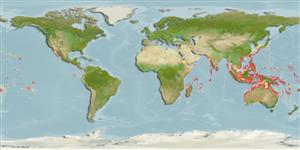Common names from other countries
>
Eupercaria/misc (Various families in series Eupercaria) >
Haemulidae (Grunts) > Plectorhinchinae
Etymology: Plectorhinchus: Greek, plektos = plaited + Greek, rhyngchos = snout (Ref. 45335).
More on author: Linnaeus.
Environment: milieu / climate zone / depth range / distribution range
Sinh thái học
Biển Cùng sống ở rạn san hô; Mức độ sâu 1 - 50 m (Ref. 9710). Tropical
Western Pacific: from Ryukyu Islands to Ogasawara Islands to the Great Barrier Reef and New Caledonia.
Bộ gần gũi / Khối lượng (Trọng lượng) / Age
Maturity: Lm ? range ? - ? cm
Max length : 72.0 cm TL con đực/không giới tính; (Ref. 9710)
Các tia vây lưng cứng (tổng cộng) : 12 - 13; Các vây lưng mềm (tổng cộng) : 18 - 20; Tia cứng vây hậu môn: 3; Tia mềm vây hậu môn: 7 - 8. This species is distinguished by the following characters: chin with 6 pores, no median pit; gill rakers on first gill arch 7-11 + 1 + 17-19 = 26-30; D XIII,18-20, 3rd to 5th spines longest; lips fleshy, moderately swollen with age; scales ctenoid (rough to touch); lateral line tubed scales about 54-58; body depth 2.6-2.9 in SL; caudal fin slightly rounded in juveniles, truncate in adults. Colour of juveniles with few horizontal to slightly oblique dark brown bands which subdivide with age until the body appears to be dark chocolate brown above, with a network of fine white lines running up and back, the broad brown bars breaking up into smaller and smaller spots on lower sides; belly white; lips and fins bright yellow, anal and caudal fins dotted with black; pectoral fins with a splash of bright crimson or scarlet red at the base (Ref. 47695, 90102).
Found in deep inner to outer reef habitats (Ref. 48635). Occurs singly or in aggregations along coral slopes of clear lagoon and seaward reefs. Juveniles solitary on shallow protected reefs (Ref. 48635). Generally nocturnal, feeding on benthic invertebrates in open sand flats and seagrass beds at night and conspicuously rests during the day (Ref. 9710, 90102). At Palau, it aggregates to spawn around new moon (Ref. 37816). Taken by handline and spear. Marketed fresh, a small quantity is salted (Ref. 47695). Maximum depth reported taken from Ref. 128797.
Life cycle and mating behavior
Maturities | Sự tái sinh sản | Spawnings | Egg(s) | Fecundities | Ấu trùng
Oviparous, distinct pairing during breeding (Ref. 205).
Conlu, P.V., 1986. Guide to Philippine flora and fauna. Fishes. Volume IX. Natural Resources Management Center, Quezon City. 495 p. (Ref. 2858)
IUCN Red List Status (Ref. 130435)
CITES (Ref. 128078)
Not Evaluated
Threat to humans
Harmless
Human uses
Các nghề cá: buôn bán nhỏ; Bể nuôi cá: Tính thương mại
Các công cụ
Special reports
Download XML
Các nguồn internet
Estimates based on models
Preferred temperature (Ref.
115969): 24.4 - 29.3, mean 28.4 (based on 3196 cells).
Phylogenetic diversity index (Ref.
82804): PD
50 = 0.5000 [Uniqueness, from 0.5 = low to 2.0 = high].
Bayesian length-weight: a=0.01202 (0.00766 - 0.01887), b=3.01 (2.88 - 3.14), in cm Total Length, based on LWR estimates for this species & Genus-body shape (Ref.
93245).
Mức dinh dưỡng (Ref.
69278): 3.9 ±0.59 se; based on food items.
Thích nghi nhanh (Ref.
120179): Trung bình, thời gian nhân đôi của chủng quần tối thiểu là 1.4 - 4.4 năm (Preliminary K or Fecundity.).
Fishing Vulnerability (Ref.
59153): Moderate vulnerability (37 of 100).
